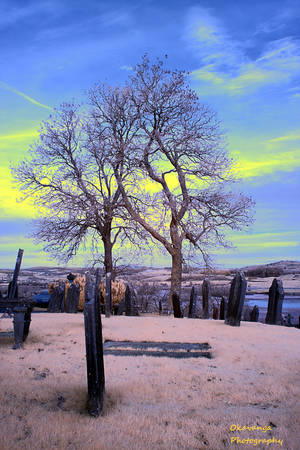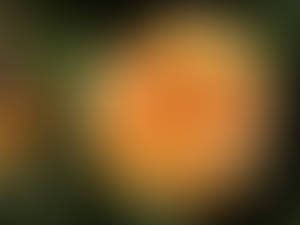The images have the following in common. A Canon 40D camera converted to full spectrum capabilities was used, fitted with an R72 infrared filter. The camera was tripod mounted. A custom white balance was employed, this having been obtained by shooting with the R72 filter in place against a standard grey card. Other than the R72 filter, no other filter was used. Light conditions were identical with the shots being taken only a few seconds apart.The images were shot in RAW mode (Standard setting) and processed with Canon's Digital Photo Professional software (DPP), supplied as part of the camera suite, and updated by download. Post-processing involved adjustment of the "Brightness" or exposure slider, and modest changes to highlight, shadow, contrast and saturation settings. The resulting RAW image was converted to Jpeg, and further processed with the Gimp photo-editing suite in order to carry out a red/blue channel swap. A disfiguring black wire was cloned out of the images and modest sharpening applied to give the final images. None of the procedures and processes described would be unfamiliar to infrared photographers. Channel swaps are a normal part of such techniques.
The difference between the two shots is, perhaps, anathema to photographers. The bright Okavanga Effect image was deliberately shot as over exposed by about 2 stops. That is the sole photographic difference. In post-processing exactly the same procedures as noted above were used, except that in order to recover a usable exposure, the "Brightness" slider was reduced by about 2 stops to compensate for the deliberate photographic over exposure. As you can see the photographic difference is very marked, yet on the face of it, there really should be no difference - over expose by two stops, recover in post-processing by two stops. Before some further comments here are some more Okavanga Effect images, all obtained by this over exposure technique.
What is going on to produce such remarkable differences? First, this is nothing to do with filters - I spent considerable time thinking this came about from the interaction of neutral density and red Cokin filters, but not so. Certainly, if other filters are present then the tonal and colour balances can be altered; for example the difference between "The Okavanga Effect Example 8" and "The Okavanga Effect Example 9" images is that one was shot with a red filter in place and the other with a neutral density filter instead of the R72 filter, but the substantial Okavanga Effect is there anyway. Nor is it to do with the camera, per se - I have examples from using an IR converted Canon 20D camera. Nor is it to do with lenses. The effect is seen with highlight areas in images. Deliberate over exposure is not necessary if there are areas that are inadvertently over exposed. The exact nature and extent of the yellow hue depends on the amount of over exposure, with variations in hue from a pure yellow to greenish-yellow, to even a gold hue.
I have only partly unravelled the answer to the origin of this effect.The yellow hue comes about from the channel swap of the red and blue channels. Prior to the swap, the yellow was its complementary colour - cyan. Fine, but then where did the cyan come from? If you look at the following sensor response curve (from MaxMax) for the Canon 40D you can see that if the red sensor response is reduced or eliminated by use of the custom white balance then the blue and green sensor responses must be enhanced. Blue and green make cyan. Thus, the cyan hue is coming from those sensors. But, why is this occurring only through over exposure, and why so markedly? Now, I have to speculate. I thought initially, that I was overexposing the blue and green channels but not the red - selective over exposure. However, having looked very closely at several sequences of shots from closely spaced exposures, all the channels appear to be over exposed. If so, why not white rather than cyan? Further, when I use different RAW processing software (UFRaw and RAWTherapee) I cannot emulate this effect. The effect, at the moment, appears to be associated with Canon's DPP software. It appears that when the "Brightness" slider is used to recover the over exposure, then the blue and green channels are treated differently from the red channel - they are differentiated from the red channel, and so a cyan hue results. I am going to coin another term here, just so I can claim to have found it! This is a "differential channel multiplier effect"! 
To recap: the Okavanga Effect of regions of bright visually dominant yellow can be seen in infrared images or images with a strong infrared component that have areas of over exposure, either adventitious or deliberate, when processed by Canon's DPP software, followed by a red/blue channel swap. The effect can be modified by, but is not dependent upon, other filters.
What would be very helpful is if someone else with a suitable infrared Canon camera and DPP software could try this technique in order to replicate the findings described here.
Finally a couple more Okavanga Effect images.
Cheers
David
UPDATE 12th December 2013.
In my haste to post this yesterday, I forgot to add thanks to Steven, Phostructor  for some discussion about the origin of the yellow/cyan colours, and to Elisabeth IRphotogirl
for some discussion about the origin of the yellow/cyan colours, and to Elisabeth IRphotogirl  for her thoughtful contributions and questions behind the scenes. Many Thanks.
for her thoughtful contributions and questions behind the scenes. Many Thanks.
David










